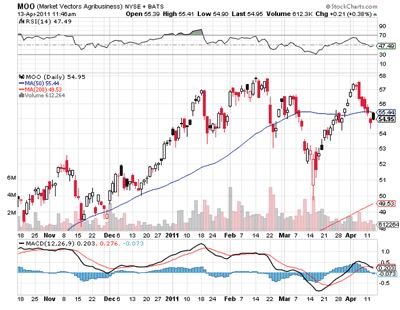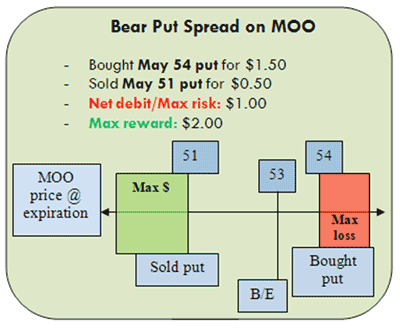Following the commodity crunch, one trader bet on continued weakness in agricultural commodities by constructing a bear put spread on a popular tracking ETF, which we’ll review in greater detail here.
The Market Vectors Agribusiness ETF (MOO) followed commodities and the broader equities market into the red on Tuesday, and it appears that at least one options trader wagered on an extended short-term retreat for the agricultural business barometer.
He wasn’t alone. In fact, MOO had seen close to 5,100 puts change hands by mid-morning on Tuesday, skyrocketing beyond its usual daily volume of fewer than 650 puts. In comparison, just 250 MOO calls had crossed the tape at the same time.
Taking a closer look at the action, we find that the bulk of the volume has centered on the May 51 and May 54 puts, which saw symmetrical blocks of 2,000 contracts—both marked "spread"—change hands early in the session.
More specifically, it appears that the trader bought the 54-strike puts for the ask price of $1.50 apiece, and simultaneously sold the 51-strike puts for the bid price of $0.50 each. In other words, it seems we've detected a bear put spread on MOO, which the strategist established for a net debit of $1 per pair of puts.
Had the investor simply bought the May 54 put for $1.50, his profit would increase with each step the ETF retreated beneath the $52.50 level (strike minus premium paid) before the soon-to-be front-month options expire.
However, should MOO retain its perch in the $54.50 neighborhood, the trader would have to forfeit the entire $1.50 paid for the put.
Instead, the speculator reduced both his maximum risk and breakeven level by writing the 51-strike puts. Now, the investor's risk is limited to $1 per pair of puts, and he'll make money as long as the stock finishes south of $53 (bought put strike minus net debit).
However, with limited risk comes limited reward. More specifically, the trader's profit potential is capped at $2 per pair of puts (difference between strikes minus net debit) no matter how far MOO should backpedal beneath the $51 level.
Graphically, here is how the profit-and-loss scenario looks:
Technically speaking, the shares of MOO have tacked on about 21% during the past 52 weeks, ushered higher atop their ten- and 20-week moving averages.
More recently, though, the ETF has consolidated its gains atop the $53-$54 level, and is now in danger of ending the week south of the aforementioned trend line duo for just the third time since July.
Should MOO surrender long-term support, an unwinding of optimism in the options pits could exacerbate the ETF's recent challenges on the charts.
By Andrea Kramer, contributor, Schaeffer’s Trading Floor Blog
















